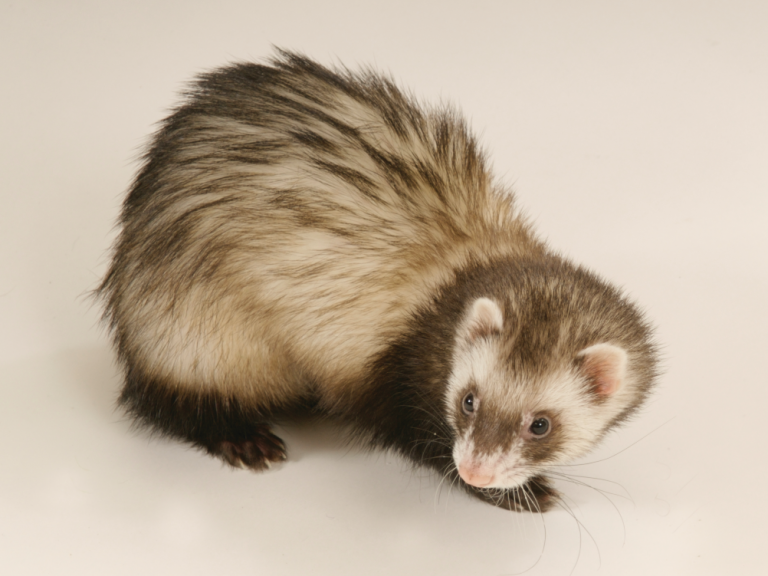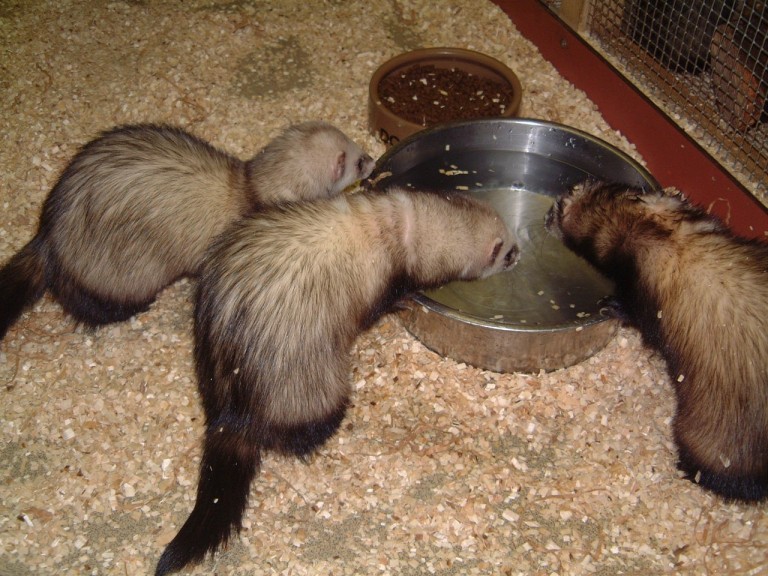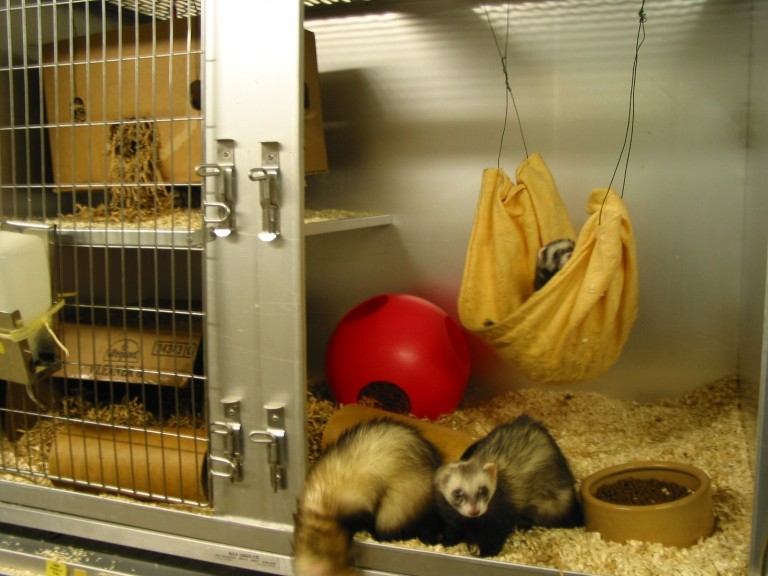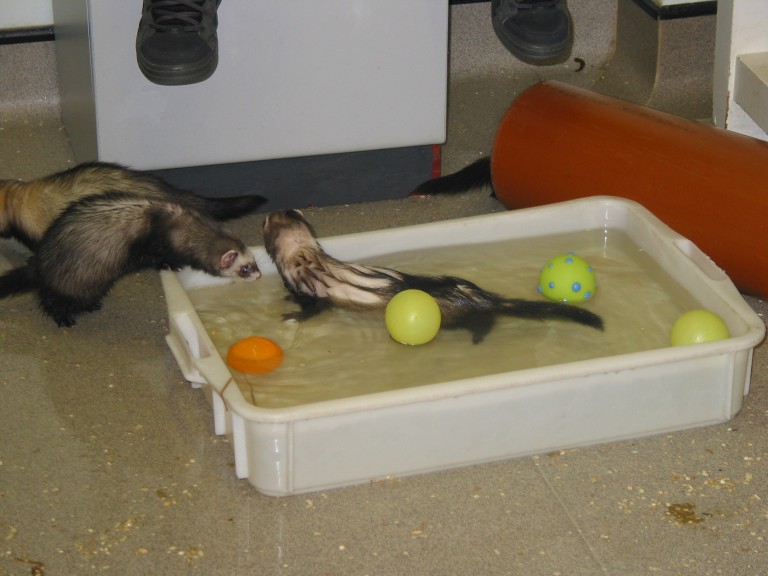Housing and husbandry: Ferret
Information to help refine the housing and husbandry of the laboratory ferret.
On this page
Introduction
Ferrets (Mustela putorius furo) belong to the family Mustelidae and are closely related to European polecats (Mustela putorius). Mustelids are terrestrial carnivores, with many anatomical features in common with the dog and cat. Male ferrets are called hobs, and females jills. They have short noses, with short furry ears, long, tubular bodies, and short limbs, allowing them to move freely in confined spaces and turn around in narrow tunnels.
Biology
Ferrets generally live between five and nine years. Males can be twice as large as females. Both sexes exhibit seasonal fluctuations of up to 30 to 40% in body weight, as subcutaneous fat is added in the autumn and shed in the spring. They lack sweat glands in the skin and regulate their body temperature by panting and other behavioural mechanisms, which renders them susceptible to overheating, particularly in humid conditions.
Several different colour variants are seen; in the laboratory, ‘fitch’ or ‘polecat’ ferrets (dark-coloured guard hairs with a cream undercoat and a dark-coloured mask and points) and albino ferrets are most common. Ferrets moult in spring and autumn.

Behaviour
Ferrets are more docile than polecats but retain many of their natural and instinctive behaviours. They are intelligent, lively, playful and curious, and are not afraid of humans. They can become very friendly if handled frequently when young, although nursing jills can be aggressive and protective of their young. They will readily enter narrow, dark tunnels resembling the burrows of rabbits and other prey animals. Ferrets are very agile and lively and need lots of space in which to explore, play and exercise to stay fit, happy and healthy. Young ferrets will play constantly. They will nip at anything, trying out their teeth, and will bite when first handled. They like to chew their playthings, so these must be chosen with care. Latex rubber items should be avoided.
Ferrets spend up to 75% of their time (often 20 hours per day) asleep, and like to sleep in dark, enclosed areas. The remainder of the time, they play intensively and explore, burrowing through their bedding which often causes them to sneeze. They are very inquisitive and exploratory and need the opportunity to forage and explore their environment. If they have insufficient stimulation, they can become bored. Ferrets are most active at dusk.
Ferrets are naturally gregarious, and can be kept in compatible pairs or groups without aggression, particularly if there is ample environmental enrichment. Ferrets produce a number of different noises. Screams are common when fighting, frightened or threatened. During play ferrets may hiss and chuckle and when foraging they may produce a low-pitched grumble.
Ferrets have relatively poor vision, although they are able to spot moving objects at close range. Their natural instinct is to nip at objects moving in their field of view, so care should be taken during approach and handling to minimise the risk of bites.

Enclosures
Ferrets should be kept in dedicated rooms, away from prey species, otherwise their strong scent will cause stress in the other animals. Housing should provide as natural an environment as possible with ample environmental enrichment, in order to ensure the physical and psychological well-being of the animals.
Enclosures should be large enough to allow the animals to perform a range of behaviours, including exploring, foraging, playing, hiding and resting, territory marking and grooming. It should also be possible for the ferrets to compartmentalise their space. Given the choice, a ferret will build itself a burrow incorporating a sleeping area, larder for storage of food, several escape holes and a separate latrine area.
Enclosures should de designed to take the natural behaviour of ferrets into account. Young animals have a tendency to gnaw objects in the environment, which can result in gastro-intestinal obstruction. In addition, they are good 'escape artists' and will squeeze through even tiny gaps, so accommodation needs to be designed with care and rendered ‘ferret-proof’, with secure fastenings.
Legal requirements and recommendations for ferret housing and husbandry can be found in Directive/2010/63/EU (Table 5) and within UK Home Office guidance (Chapter 6 within sections 1,2 and 3).

Cleaning
The pen should be cleaned daily, removing any bedding that is wet or dirty, removing any uneaten fresh food and cleaning the food and water containers. The litter tray or latrine area should also be cleaned out daily and the pen should be completely cleaned weekly.
Ferrets are very clean and usually choose one or two particular areas for the latrine, usually a vertical surface against which they can eliminate. They can be trained to use a litter tray. Ferret litter trays are normally corner-shaped and have two high sides, because their faeces are soft and they tend to back into a corner and squirt upwards when eliminating.
Social housing
Ferrets are sociable and should be kept in compatible pairs or groups wherever possible. Jills (without litters), young animals before puberty and castrated males should be group housed. A jill and a hob may be kept together, although they may fight when a litter is born and are best separated for this period. Group housed animals should be observed daily for any signs of aggression.
Enrichment and exercise
A stimulating environment is essential for ferret welfare. Ferrets need things that they can climb on, play with and explore, and access to safe hiding places, such as tunnels and closed hammocks. An ‘artificial warren’ can be created using plastic tubes, branches, cardboard boxes and paper bags, with a sleeping area or nest box, a larder area, and a vertical surface to act as a latrine. Dry food can be scattered around the cage and hidden in tubes, to encourage interest and activity.
Ferrets should be given sufficient opportunities to exercise, and ferrets kept in small cages should be allowed out for exercise regularly, ideally daily. Many ferrets enjoy playing in water; a shallow water bath containing fresh water at room temperature provided once a week can be a good form of enrichment. They should have solid floors, with a thick layer of bedding.

Environmental conditions
Ferret housing should be well ventilated, dry and draught free. Ferrets thrive in temperatures between 15 and 24oC, but will adapt to colder temperatures (7 to 10oC), with the exception of unweaned kits, which should always be kept between 15oC and 24 oC. Ferrets are susceptible to heat stress above 30oC , particularly if humidity is high. The optimum humidity is between 40% and 65%.
Identification
Ferrets can be identified in a number of ways:
- Individual fitch animals may be identified by their appearance; however, seasonal changes in the pelage can make identification difficult.
- Microchips can be implanted under the skin between the shoulder blades to provide permanent identification. Be aware that the skin can be tough in this area.
- Marker dyes applied to the coat or clipping small areas of coat can provide temporary methods for marking animals.
- Collars can be used; however, the thick neck and narrow head of this species makes it challenging to prevent collars from slipping off without fastening them too tightly.
Nutrition
Nutritional requirements for ferrets have not been extensively studied. Ferrets have a typical carnivore digestive system, with large mouths, typical carnivore teeth and short, powerful jaws, which produce a shearing action when chewing. They have a simple stomach, and vomit readily. Both small and large intestine are short, leading to a short gut transit time; food passes through the entire intestine in only about three to four hours.
Ferrets are strict carnivores and need a high protein (30 to 40%), meat-based diet. Inadequate protein levels lead to insufficient weight gain, inappropriate weight loss and poor reproductive performance. They eat to calorie requirements, and the high metabolic rate and short gut transit time means they need highly digestible diets with a high energy density and protein level. Diets rich in carbohydrates can lead to protein and fat deficiencies. Additionally, ferrets cannot digest large amounts of fibre or starches so these should not be fed. They have high metabolic rates and eat little and often. Ad libitum feeding or feeding little and often is better than feeding once or twice daily. Under natural conditions, they will eat up to ten small meals daily. Ferrets may be given treats in small amounts, such as small pieces of meat or commercial cat or ferret treats. Old food should be removed from the pen regularly.
The amount of food requires depends on age, bodyweight, level of activity, reproductive status, health status and the type of food provided. Bodyweight and body condition should be assessed frequently, taking seasonal fluctuations into account, to ensure nutrition is adequate, especially in group housed animals. Sudden changes in diet may lead to digestive disturbances. Any diet changes should be made gradually. Food can be used to stimulate foraging behaviour, as a form of environmental enrichment. For example, dry food can be hidden in substrate. Fresh water should be provided ad libitum.
Reproduction
Ferrets reach puberty in the spring following birth at approximately 9 to 12 months of age. They are seasonal breeders: in the northern hemisphere, females are active between March and September, and males from December to July. This is determined by photoperiod. Females are seasonally polyoestrous between March and September; however they are induced ovulators and will remain in heat for three to six months if not mated. The high level of oestrogen present during oestrus can be detrimental, leading to bone marrow depression and anaemia. For animals which are not going to be mated it is recommended to either neuter them or give hormone treatments to prevent the animal coming into oestrus. Neutering can increase the risk of hyperadrenocorticism in ferrets but hormone treatments need to be repeated multiple times so the most appropriate option will depend on individual circumstances and should be discussed with your named veterinary surgeon.
Mating in ferrets can be vigorous, prolonged and noisy, with the male grasping the female by the scruff of the neck and dragging her around the cage. Gestation lasts 40 to 44 days. An average of eight kits is born, weighing approximately 6 to 12g. Kits have voracious appetites, and should stay with their mother until they are at least eight weeks old.
Routine care
- Regular checks should be done on the teeth, skin and hair coat, ears (the ear mite Otodectes cynotis is common) and anal area for evidence of diarrhoea. The nails may also need trimming.
- It is essential to control oestrus in jills that will not be mated. They should be spayed or treated with hormones to suppress oestrus.
- Ferrets may need to be vaccinated against canine distemper, depending on the degree of biosecurity employed.
- New arrivals of unknown health status may need faecal screening for pathogens such as Salmonella and Campylobacter, and blood sampling for haematology, serology, and biochemistry.
- Ferrets which have been imported and those covered by a pet passport may need to be vaccinated against rabies.
- Ferrets are not regarded as susceptible to feline panleucopenia, canine parvovirus, leptospirosis or mink enteritis.
Recognising poor welfare
Ferrets with poor welfare exhibit behavioural changes or physical signs including:
- Loss of appetite.
- Weight loss/loss of condition.
- Drinking more or less than normal.
- Lethargy/sleeping more than usual.
- Diarrhoea.
- Unusual swellings.
- Skin changes.
- Alopecia or other change in hair coat.
- Limping.
- Unusual bleeding.
- Sensitivity to touch.
- Runny eyes or nose.
- Unusual vocalisation.
Summary of key features of housing and husbandry
- Ferrets should be housed in compatible social groups.
- High humidity levels should be avoided, and enclosures should be well ventilated.
- Temperature should be kept in the range 15 to 24°C, with enough bedding for the animals to create microenvironments within the enclosure.
- Enclosures should be secure and escape proof, with enough vertical height to at least allow the animals to stand fully upright on their back legs.
- Enclosures should be large enough to allow compartmentalisation of space (e.g. for elimination, eating and food storage, resting, social play and interacting with environmental enrichment).
- Floors should be smooth, solid, non-slip and covered with substrate.
- A vertical surface for scent marking and use as a latrine, well away from the eating and sleeping areas should be provided.
- A warm, dry resting/sleeping chamber containing comfortable nesting material should be provided.
- Ferrets should be housed in a complex and stimulating environment. Physical enrichment may include containers and tubes, paper bags and hammocks, water baths and ladders.
- Ferrets should be handled regularly and confidently.
- Diet should be high in animal protein and fat content and low in fibre and carbohydrate content. Feeding should be ad lib or little and often, with free access to water.
-
If females will not be used for breeding, oestrus should be controlled by neutering or hormone injections.
Related resources
Bibliography
- Fox JG (1998). Biology and diseases of the ferret, 2nd edition. Williams and Wilkins.
- Fox JG and Marini RP (2014). Biology and diseases of the ferret, 3rd edition. John Wiley & Sons.
- Hubrecht R and Kirkwood J (eds) (2010). The UFAW Handbook on the Care and Management of Laboratory and Other Research Animals, 8th edition. Wiley-Blackwell.
- Keeble E and Meredith A (2009). BSAVA Manual of Rodents and Ferrets. BSAVA.
- Lewington JH (2000). Ferret husbandry, medicine and surgery. Butterworth-Heinemann.
- Lewington JH (2007). Ferret husbandry, medicine and surgery. Elsevier Saunders.
- Lloyd M (1999). Ferrets: Health, husbandry and diseases. Wiley.
- Porter V and Brown N (1993). The complete book of ferrets. D&M Publications.
- Quesenberry K and Carpenter J (2012). Ferrets, Rabbits, and Rodents: Clinical Medicine and Surgery, 3rd edition. Elsevier.
- Schoemaker NJ and Hawkins MG (2007). Hyperadrenocorticism in ferrets: clinical updates. Proceedings of the Association of Exotic Mammal Veterinarians (Providence, August 4–9 2007), 79–84.
- Talbot S, Freire R and Wassens S (2014). Effect of captivity and management on behaviour of the domestic ferret (Mustela putorius furo). Applied Animal Behaviour Science 151: 94–101. doi: 10.1016/j.applanim.2013.11.017
- Van Oostrom H, Schoemaker NJ and Uilenreef JJ (2011) Pain management in ferrets. Veterinary Clinics of North America: Exotic Animal Practice 14(1): 105–116. doi: 10.1016/j.cvex.2010.09.001
- van Zeeland YRA et al. (2014). Use of a GnRH agonist implant as alternative for surgical neutering in pet ferrets. Veterinary Record 175: 66. doi: 10.1136/vr.102389
- Wolfensohn S and Lloyd M (2013). Handbook of Laboratory Animal Management and Welfare, 4th edition. Wiley Blackwell.
